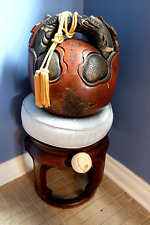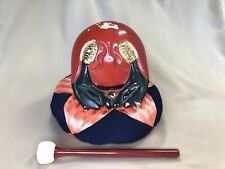|

On eBay Now...
Antique MOKUGYO Japanese Wooden Temple Bell, Circa 1820, Rosewood Stand, Cushion For Sale

When you click on links to various merchants on this site and make a purchase, this can result in this site earning a commission. Affiliate programs and affiliations include, but are not limited to, the eBay Partner Network.

Antique MOKUGYO Japanese Wooden Temple Bell, Circa 1820, Rosewood Stand, Cushion:
$500.00
Large antique Japanese mokugyo, fish bell, carved of keyaki (zelkova, elm) wood. This wooden temple bell was used by Buddhist priest during religious ceremonies and chants. Laid on it’s side on a pillow, the bell was struck to a rhythm to match the cadence of the chant. The carving on the bell is of two fish embracing a pearl, a symbol of unity. The fish themselves symbolize wakefulness, in this case to remind the chanters to focus on the sutra.
Circa: 1820
Summary
Mokugyo (a fish-shaped wooden drum) is intended to keep the rhythm of sutra chanting by beating and sounding. It also helps to awaken people in sutra chanting. It is used in Zen sect, Tendai sect, and Jodo sect. The use of Mokugyo was once prohibited in Jodo sect, but afterward, it came to be used when sutra was chanted.
It is placed on a small zabuton (traditional Japanese cushions used to sit on the floor)-like table, and it sounds like \'poku poku\' when it is beaten with a plectrum whose top is wrapped in cloth. It ranges in size from about six centimeters to the size close to one meter in diameter. It looks like a bell which is designed from a fish eating its own tail, or two fishes and a dragon competing for a gem. The uroko (scale pattern) of fish is carved on its surface. It is made from wood like camphor tree. The inside of Mokugyo is hollowed. It is cut from an opening; \'sound hole\' of Mokugyo to make a hollow inside. The original model of Mokugyo is \'gyoban\' or \'gyoku\' (wooden gong shaped like a fish) which was used in Zen. Gyoban (wooden gong shaped like a fish) is a fish-shaped board as its name suggests, and it was beaten to give a signal to call people together. It is believed that its fish-like shape was a symbol of devoting one to training since a fish never closes its eyes at any time during the day or night. It is also considered that beating the belly of fish helped one throw up his/her earthly desires. This may be extra information, but it is said that it made steady rhythms in order to keep people awake. By the Ming Dynasty, the shape of Mokugyo that is seen today was established.
It is said that Ingen Osho, who came from abroad in the early Edo period, spread it in Japan. Mokugyo of the Muromashi period has also been handed down. In addition, thestand is made of rosewood.
What is included: - Antique Bell
- Wooden gong
- Rosewood stand
- Blue cushion
Dimensions and weight: - Bell Size: H 14\" X L 13\" X D 11\"
- Total Bell length with stand and cushion: 31½\"
- Total weight: 22 lbs


Antique MOKUGYO Japanese Wooden Temple Bell, Circa 1820, Rosewood Stand, Cushion $500.00

Antique Japanese Buddhism Buddhist tools actually used in temples Mokugyo 木魚. $130.00

Antique Buddhist Temple Block Wood Fish Bell Japanese MOKUGYO Extra Large 3700g $255.00

Y4197 MOKUGYO Buddhist Monk Instrument lacquered Japan antique Buddhism altar $100.00

Antique Japanese Mokugyo Buddhist Drum Keyaki Wood 6" $97.75
|